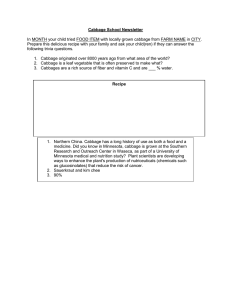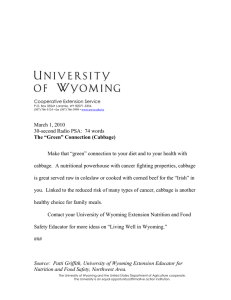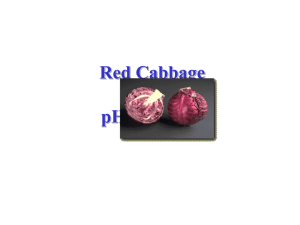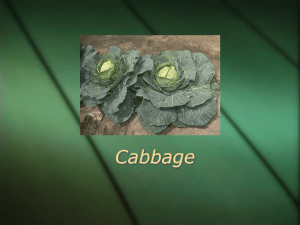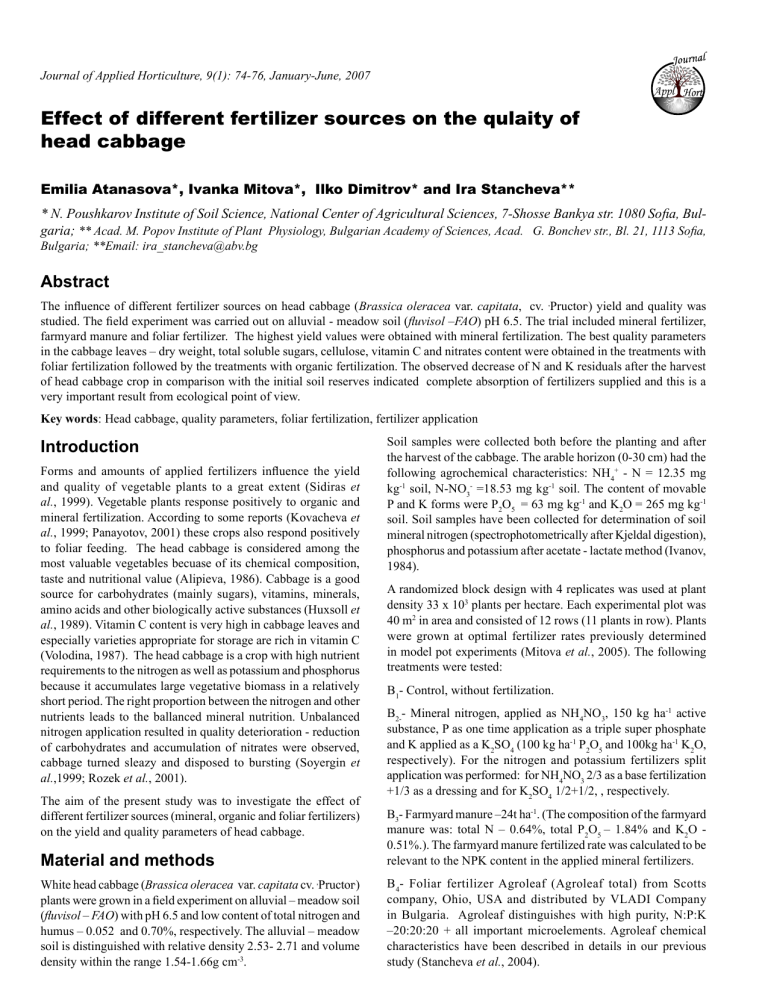
Journal of Applied Horticulture, 9(1): 74-76, January-June, 2007 Appl Effect of different fertilizer sources on the qulaity of head cabbage Emilia Atanasova*, Ivanka Mitova*, Ilko Dimitrov* and Ira Stancheva** * N. Poushkarov Institute of Soil Science, National Center of Agricultural Sciences, 7-Shosse Bankya str. 1080 Soa, Bulgaria; ** Acad. M. Popov Institute of Plant Physiology, Bulgarian Academy of Sciences, Acad. G. Bonchev str., Bl. 21, 1113 Soa, Bulgaria; **Email: ira_stancheva@abv.bg Abstract The inuence of different fertilizer sources on head cabbage (Brassica oleracea var. capitata, cv. ,Pructor,) yield and quality was studied. The eld experiment was carried out on alluvial - meadow soil (uvisol –FAO) pH 6.5. The trial included mineral fertilizer, farmyard manure and foliar fertilizer. The highest yield values were obtained with mineral fertilization. The best quality parameters in the cabbage leaves – dry weight, total soluble sugars, cellulose, vitamin C and nitrates content were obtained in the treatments with foliar fertilization followed by the treatments with organic fertilization. The observed decrease of N and K residuals after the harvest of head cabbage crop in comparison with the initial soil reserves indicated complete absorption of fertilizers supplied and this is a very important result from ecological point of view. Key words: Head cabbage, quality parameters, foliar fertilization, fertilizer application Introduction Forms and amounts of applied fertilizers inuence the yield and quality of vegetable plants to a great extent (Sidiras et al., 1999). Vegetable plants response positively to organic and mineral fertilization. According to some reports (Kovacheva et al., 1999; Panayotov, 2001) these crops also respond positively to foliar feeding. The head cabbage is considered among the most valuable vegetables becuase of its chemical composition, taste and nutritional value (Alipieva, 1986). Cabbage is a good source for carbohydrates (mainly sugars), vitamins, minerals, amino acids and other biologically active substances (Huxsoll et al., 1989). Vitamin C content is very high in cabbage leaves and especially varieties appropriate for storage are rich in vitamin C (Volodina, 1987). The head cabbage is a crop with high nutrient requirements to the nitrogen as well as potassium and phosphorus because it accumulates large vegetative biomass in a relatively short period. The right proportion between the nitrogen and other nutrients leads to the ballanced mineral nutrition. Unbalanced nitrogen application resulted in quality deterioration - reduction of carbohydrates and accumulation of nitrates were observed, cabbage turned sleazy and disposed to bursting (Soyergin et al.,1999; Rozek et al., 2001). The aim of the present study was to investigate the effect of different fertilizer sources (mineral, organic and foliar fertilizers) on the yield and quality parameters of head cabbage. Soil samples were collected both before the planting and after the harvest of the cabbage. The arable horizon (0-30 cm) had the following agrochemical characteristics: NH4+ - N = 12.35 mg kg-1 soil, N-NO3- =18.53 mg kg-1 soil. The content of movable P and K forms were P2O5 = 63 mg kg-1 and K2O = 265 mg kg-1 soil. Soil samples have been collected for determination of soil mineral nitrogen (spectrophotometrically after Kjeldal digestion), phosphorus and potassium after acetate - lactate method (Ivanov, 1984). A randomized block design with 4 replicates was used at plant density 33 x 103 plants per hectare. Each experimental plot was 40 m2 in area and consisted of 12 rows (11 plants in row). Plants were grown at optimal fertilizer rates previously determined in model pot experiments (Mitova et al., 2005). The following treatments were tested: B1- Control, without fertilization. B2-- Mineral nitrogen, applied as NH4NO3, 150 kg ha-1 active substance, P as one time application as a triple super phosphate and K applied as a K2SO4 (100 kg ha-1 P2O5 and 100kg ha-1 K2O, respectively). For the nitrogen and potassium fertilizers split application was performed: for NH4NO3 2/3 as a base fertilization +1/3 as a dressing and for K2SO4 1/2+1/2, , respectively. Material and methods B3- Farmyard manure –24t ha-1. (The composition of the farmyard manure was: total N – 0.64%, total P2O5 – 1.84% and K2O 0.51%.). The farmyard manure fertilized rate was calculated to be relevant to the NPK content in the applied mineral fertilizers. White head cabbage (Brassica oleracea var. capitata cv. ,Pructor,) plants were grown in a eld experiment on alluvial – meadow soil (uvisol – FAO) with рН 6.5 and low content of total nitrogen and humus – 0.052 and 0.70%, respectively. The alluvial – meadow soil is distinguished with relative density 2.53- 2.71 and volume density within the range 1.54-1.66g cm-3. B 4- Foliar fertilizer Agroleaf (Agroleaf total) from Scotts company, Ohio, USA and distributed by VLADI Company in Bulgaria. Agroleaf distinguishes with high purity, N:P:K –20:20:20 + all important microelements. Agroleaf chemical characteristics have been described in details in our previous study (Stancheva et al., 2004). Effect of different fertilizer sources on the qulaity of head cabbage 140 Agroleaf was applied with high pressure spray, 5 times during the vegetation period at 10 day intervals at rates 5 kg ha-1 or 0.5% solution starting 3 weeks after planting. After young seedling formation, each plot was covered by a pellucid plastic lm to avoid penetration into the soil of the ier foliar fertilizer. Cabbage quality parameters at crop harvest are shown in Table 1. Changes in dry weight, vitamin C, sugars and cellulose dependence on fertilizer source are more indicative for the white head cabbage quality. Dry matter is one of the main parameters of quality and it is genetically determined (Alipieva, 1986). Dry weight showed maximal values in the organic fertilized cabbage closely followed by mineral fertilization. As reported earlier by Stoicheva et al. (2002) the productivity of the vegetable crops grown in a crop rotation was determined mainly by the N- rate rather than the N - way of application and N - source. Cabbage is a good source for fiber and vitamins, these characteristics are considered as quality parameters. The highest value of sugars and vitamin C were observed in cabbage leaves with foliar fertilization. King and Bolin (1989) suggested that increased protein content and reduced carbohydrates deteriorate quality and storage of the vegetable produce. The vitamin C values in the cabbage leaves are much higher in comparison with other leafy vegetables and negative correlation was found between 120 bc 110 ab a Data are expressed as means ± standard error. Comparison of means was performed by the Fisher LSD test (P = 0.05) after performing multifactor ANOVA analysis. The STASTICA (version 6.0) package was used for statistical analysis. The highest cabbage yield (121 t ha-1 ) was obtained from the treatments with mineral fertilization followed by organic fertilization (Fig.1). The yields obtained from the foliar fertilization were higher than the control but differences were not signicant. c -1 Crop Yield (q ha ) 130 At the cabbage harvest the following parameters were measured: yield of fresh biomass, dry weight, vitamin C content and cellulose (Ermakov et al., 1952), total soluble sugars (Dubois, 1956). The content of nitrates was determined by Nitrachek from Hawk Creek Laboratory Inc. USA. Results and discussion 75 100 90 B1 B2 B3 B4 Fig. 1. Head cabbage crop yield under different treatments. Different letters indicate signicant differences assessed by Fisher LSD test (P≤0.05) after performing ANOVA. nitrate nitrogen and vitamin C in the cabbage leaves sap (Volodina, 1987). As it was shown in our previous study (Atanasova and Stancheva, 2004) vitamin C accumulation was found to be higher in the varieties with prolonged period of vegetative phase. Among the carbohydrates with high molecular weight, pectin and cellulose occupy an important place. The cellulose content in the foliar fed plants was low while the highest cellulose values were observed under mineral fertilization. High nitrates accumulation in the leaves of some leafy vegetables is closely related to the nitrogen nutrition (Gonnella et al., 2000) and duration of the vegetative phase (Reinken, 1992). Head cabbage is among the vegetable crops which can accumulate considerable nitrate dependending upon the climate, soil composition and properties, fertilizer sources and rates (Rankov, 1990; Amelin, 1996). Nitrate content was maximum in the leaves of mineral fertilized plants, while in the foliar fed plants the lowest values were found. The content of nitrates in the leaves of the plants remained much lower than the acceptable limit concentration – 500 mg kg-1 fresh weight. The soil content of accessible forms of the main macronutrients N, P, K after harvest of the cabbage indicated (Table 2) availability Table 1. Effect of fertilization on cabbage quality parameters Treatments Dry weight Vitamin C Soluble sugars (%) (mg 100g-1 fresh weight) (mg100g-1 dry weight) B1 (Control) 6.24±0.29*a 42.60±2.2a 1.02±0.04b B2 (Mineral fertilization) 7.08±0.35b 63.85±3.3c 0.82±0.03a B3 (Organic fertilization) 7.22±0.44b 52.80±2.6b 1.07±0.06bc B4 (Foliar fertilization) 6.69±0.23ab 74.80±4.4d 1.16±0.07c Cellulose (% dry matter) 9.36±0.47b 10.53±0.53c 8.82±0.44ab 8.42±0.42a NO3(mg kg fresh weight) 68±3.8c 316±14.1d 32±2.1b 16±0.9a -1 *Values are means ± S.E., n=4. Different letters indicate signicant differences assessed by Fisher LSD test (P≤0.05) after performing ANOVA Table 2. Changes in chemical parameters of soil after harvest of cabbage crop Treatments Mineral nitrogen (mg kg-1 soil) + N-NH4 N-NO3Total Initial level 12.35 18.53 30.88 3.35 5.3 8.65 B1 (Control) 5.7 3.68 9.38 B2 (Mineral fertilization) 6.37 5.70 12.07 B3 (Organic fertilization) 6.03 4.36 10.39 B4 (Foliar fertilization) Mobile P and K forms (mg kg-1 soil) P2O5 K2O 63 265 63 92 84 62 110 62 72 62 pH (H2O) 6.5 6.7 6.6 6.9 6.7 (КСl) 6.1 6.1 5.9 6.2 5.9 76 Effect of different fertilizer sources on the qulaity of head cabbage of residual quantities of macronutrients, compared to the initial levels in the soil. The content of NH4+- N , NO3- - N and K2O after the crop harvest was lower than the initial levels in all fertilized treatments, therefore no residuals of nitrogen and potassium accessible forms were found. An increase of phosphorus level was observed in the all fertilized treatments especially in the treatments with organic fertilization, which could be due to the high phosphorus content in the farm yard manure. Changes in soil pH in the treatments with applied mineral, organic and foliar fertilizers are negligible (Table 2). Soil agrochemical analyses after head cabbage crop harvest indicated that the nitrogen and potassium from the applied fertilizers were mostly absorbed by the plants. Signicantly higher yields of cabbage cv. ‘Pructor ’ grown on the alluvial – meadow soil (uvisol- FAO) with different fertilizer sources was obtained after application of mineral fertilizers followed by the treatments with organic fertilizers. Fresh cabbage produce with best quality parameters (maximal levels of total soluble sugars and vitamin C and minimal content of cellulose and nitrates) were obtained as a result of foliar fertilization. Supplied optimal fertilizer rates were assimilated by the plants because no N and K residuals in the arable soil horizon were found and no nitrate accumulation above acceptable limit concentration was measured. Acknowledgement The study was conducted with a nancial support of National Science Fund, Ministry of Education and Science, Bulgaria. References Amelin, A.A., C.E. Amelina, O.A. Sokolov and J. Horn, 1996. Impact of environmental and inner factors on the nitrate accumulation in plants. Agrochemistry, 6: 23-28 (in Russian). Atanasova, E. and I. Stancheva, 2004. Biochemical characteristics used as quality parameters in white head cabbage at different nitrogen rates, sources and ways of application. Ecology Future, 3(3): 37-43. Alipieva, M. 1986. Head cabbage. Zemizdat. Soa (in Bulgarian) Dubois, M., K.A. Giles, J.K. Hamilton, P.A. Rebers and F. Smith, 1956. Colorimetric method for determination of sugars and related substances. Anal. Chem., 28: 350-356. Ermakov, A.I., V.V. Arasimovich, M.I. Smirnova-Ikonnikova and I.K. Murry, 1952. Methods of biochemical study in plants. GISL, Moscow. (in Russian) Huxsoll, C., H. Bolin and A. King, 1989. Quality factors of fruits and vegetables - Chemistry and technology. American Chemical Society, Washington, D.C. Gonnella, M., G. Gonversa and A. Elia, 2000. Nitrogen level yield and nitrate accumulation in soilless grown lettuce (Lactica sativa L.). Proceeding of Scientic meeting of Italian Horticultre Society, held at Sirmone, Brescia, Italy from 28-30th May, 2000. Ivanov, P. 1984. A new acetate-lactate method for determination of accessible soil phosphorus and potassium for plants. Soil Sci. Agrochem., 19: 88-96 (in Bulgarian). King, J. and H. Bolin, 1989. Physiological and microbial storage stability of minimally processed fruits and vegetables. Food Technol., 43: 132-135. Kovacheva, T., S. Pandev and D. Jancheva,1999. Nitrate reductase activity changes in oriental tobacco treated with Tabex and Lactofol. Proceedings of National Conference “Postigenia i perspektivi na mineralnoto hranene i vodniya regim na rasteniayata” held at Institute of Plant Physiology - Bulgarian Academy of Science, Soa, 9-10th November, 1999, 36-39 (in Bulgarian with English abstract). Mitova, I., E. Atanasova and I. Stancheva, 2005. Fertlization as a factor for yield and quality formation of head cabbage. Ecology and Industry, 7: 182-184 (in Bulgarian). Panayotov, N. 2001. Effects of foliar fertilizers Campofort on the pepper morphological characteristics and productivity. Proceedings of National Conference “Postigenia i perspektivi na mineralnoto hranene i vodniya regim na rasteniayata” held at Institute of Plant Physiology - Bulgarian Academy of Science, Soa, 9-10 October, 2000, 85-88 (in Bulgarian with English abstract). Rankov, V. 1990. About the nitrate content in vegetables. Agricultural Science, 28(2): 36-41 (in Bulgarian). Reinken, G. 1992. Nitrat in Gemn-fordet oder hemmt es die Gesundheit. Gemuse, 7: 361-370. Rozek, S., R. Wojciechowska and A. Rydz, 2001. Effect of differentiated nitrogen fertilization on the content of certain nutritive compounds in winter cabbage heads. Folia Horticulture, 13(2): 13-22. Sidiras, N., C. Avgoulas, D. Bilalis and N. Tsougrianis, 1999. Effects of tillage and fertilization on biomass, roots, N-accumulation and nodule bacteria of vetch (Vicia sativa cv. Alexander). J Agron. Crop Sci., 182(3): 209-216. Stancheva, I., I. Mitova and Z. Petkova, 2004. Effects of different nitrogen sources on the yield, nitrate content and other physiological parameters in garden beans. Environmental and Experimental Botany, 52: 277-282. Stoicheva, D., P. Aleksandrova, D. Donov, D. Stoichev, G. Angelov and L. Raikova, 2002. Ecological assessment of different nitrogen fertilizer rates in a vegetable crop rotation. Bulgarian Journal of Agricultural Science, 8: 141-150. Soyergin, S., N. Surmeli and I. Moltay, 1999. Commercial fertilizer requirements of white cabbage. Proceedings of 3th Turkish Nationlal Horticultural Congress, held in September, 1999. Volodina, T.I. 1987. Head cabbage quality in yield prediction using sap diagnostics method. Nauchno tekhnicheskij byulletin – VNII zernovogo hozyajstva, Omsk (in Russian)
